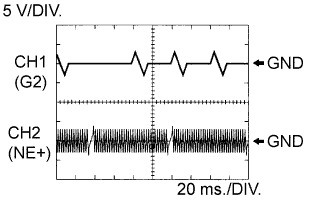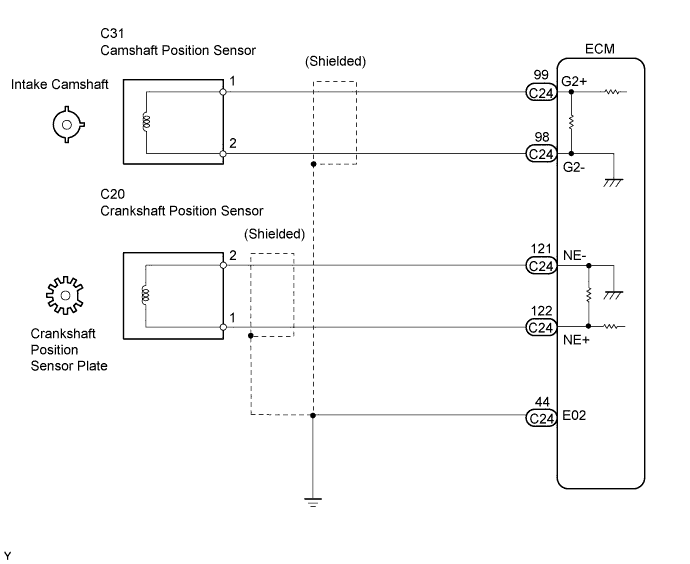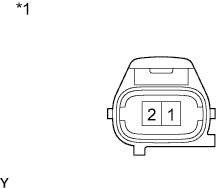Dtc P0335 Crankshaft Position Sensor A Circuit
DESCRIPTION
WIRING DIAGRAM
INSPECTION PROCEDURE
READ VALUE USING INTELLIGENT TESTER (ENGINE SPEED)
INSPECT CRANKSHAFT POSITION SENSOR (RESISTANCE)
CHECK HARNESS AND CONNECTOR (CRANKSHAFT POSITION SENSOR - ECM)
CHECK SENSOR INSTALLATION (CRANKSHAFT POSITION SENSOR)
INSPECT NO. 1 CRANKSHAFT POSITION SENSOR PLATE (TEETH OF SENSOR PLATE)
REPLACE CRANKSHAFT POSITION SENSOR
CHECK WHETHER DTC OUTPUT RECURS
DTC P0335 Crankshaft Position Sensor "A" Circuit |
DTC P0339 Crankshaft Position Sensor "A" Circuit Intermittent |
DESCRIPTION
The crankshaft position sensor system consists of a No. 1 crankshaft position sensor plate and a pickup coil.The No. 1 crankshaft position sensor plate has 34 teeth and is installed on the crankshaft. The pickup coil is made of wound copper wire, an iron core and a magnet. The No. 1 crankshaft position sensor plate rotates and, as each tooth passes by the pickup coil, a pulse signal is created. The pickup coil generates 34 signals per engine revolution. Based on these signals, the ECM calculates the crankshaft position and engine speed. Using these calculations, the fuel injection duration and ignition timing are controlled.DTC No.
| DTC Detection Condition
| Trouble Area
|
P0335
| When one of the following conditions is met (1 trip detection logic) :
- No crankshaft position sensor signal to ECM while cranking
- No crankshaft position sensor signal to ECM while engine running
- Missing crankshaft position sensor signal despite camshaft position sensor signal inputs normal after engine cranked
| - Open or short in crankshaft position sensor circuit
- Crankshaft position sensor
- Crankshaft position sensor plate
- ECM
|
P0339
| Under conditions (a), (b) and (c), no crankshaft position sensor signal to ECM for 0.05 seconds or more:
(1 trip detection logic)
(a) Engine speed 1000 rpm or more
(b) Starter signal OFF
(c) 3 seconds or more have elapsed since starter signal switched from ON to OFF
| - Open or short in crankshaft position sensor circuit
- Crankshaft position sensor
- Crankshaft position sensor plate
- ECM
|
- Reference: Inspection using an oscilloscope.
- HINT:
- The correct waveform is as shown.
- G2 is camshaft position sensor signals, and NE+ is the crankshaft position sensor signal.
- A failure of the ground for the shielding of the wiring may result in noisy waveforms.
ECM Terminal Name
| CH1: Between G2+ and G2-
CH2: Between NE+ and NE-
|
Tester Range
| 5 V/DIV., 20 ms./DIV.
|
Condition
| Idling with warm engine
|
WIRING DIAGRAM
INSPECTION PROCEDURE
- HINT:
- After performing the inspection procedure for the crankshaft position sensor, if DTC P0335 and/or P0339 are output again, check the following items related to the camshaft position sensor.
- Installation condition of the camshaft position sensor
- Installation condition of the camshaft
- Connection of the camshaft position sensor connector
- If no problem is found through this diagnostic troubleshooting procedure, troubleshoot the engine mechanical systems.
- Check the engine speed. The engine speed can be checked using the intelligent tester. To check, follow the operation below:
- Connect the intelligent tester to the DLC3.
- Start the engine.
- Turn the tester on.
- Enter the following menus: Powertrain / Engine and ECT / Data List / All Data / Engine Speed.
- The engine speed may be indicated as zero despite the engine rotating normally. This is caused by a lack of NE signals from the crankshaft position sensor. Alternatively, the engine speed may be indicated as lower than the actual engine speed if the crankshaft position sensor output voltage is insufficient.
- Read freeze frame data using the intelligent tester. The ECM records vehicle and driving condition information as freeze frame data the moment a DTC is stored. When troubleshooting, freeze frame data can be helpful in determining whether the vehicle was running or stopped, whether the engine was warmed up or not, whether the air fuel ratio was lean or rich, as well as other data recorded at the time of a malfunction.
| 1.READ VALUE USING INTELLIGENT TESTER (ENGINE SPEED) |
Connect the intelligent tester to the DLC3.
Turn the ignition switch to ON.
Turn the tester on.
Enter the following menus: Powertrain / Engine and ECT / Data List / All Data / Engine Speed.
Start the engine.
Read the values displayed on the tester while the engine is running.
- OK:
- Correct values are displayed.
- HINT:
- To check the engine speed change, display the graph on the intelligent tester.
- If the engine does not start, check the engine speed while cranking.
- If the engine speed indicated on the intelligent tester remains at zero (0), there may be an open or short in the crankshaft position sensor circuit.
| 2.INSPECT CRANKSHAFT POSITION SENSOR (RESISTANCE) |
Disconnect the crankshaft position sensor connector.
Measure the resistance between terminals 1 and 2.
- Standard resistance:
Tester Connection
| Specified Condition
|
1 - 2
| 1,150 to 1,450 Ω (at 20°C (68°F))
|
Text in Illustration*1
| Component without harness connected
(Crankshaft Position Sensor)
|
Reconnect the crankshaft position sensor connector.
| 3.CHECK HARNESS AND CONNECTOR (CRANKSHAFT POSITION SENSOR - ECM) |
Disconnect the crankshaft position sensor connector.
Disconnect the ECM connector.
Measure the resistance according to the value(s) in the table below.
- Standard Resistance (Check for Open):
Tester Connection
| Condition
| Specified Condition
|
C20-1 - C24-122 (NE+)
| Always
| Below 1 Ω
|
C20-2 - C24-121 (NE-)
| Always
| Below 1 Ω
|
- Standard Resistance (Check for Short):
Tester Connection
| Condition
| Specified Condition
|
C20-1 or C24-122 (NE+) - Body ground
| Always
| 10 kΩ or higher
|
C20-2 or C24-121 (NE-) - Body ground
| Always
| 10 kΩ or higher
|
Reconnect the crankshaft position sensor connector.
Reconnect the ECM connector.
| | REPAIR OR REPLACE HARNESS OR CONNECTOR (CRANKSHAFT POSITION SENSOR - ECM) |
|
|
| 4.CHECK SENSOR INSTALLATION (CRANKSHAFT POSITION SENSOR) |
Check the crankshaft position sensor installation.
- OK:
- Sensor is installed correctly.
| 5.INSPECT NO. 1 CRANKSHAFT POSITION SENSOR PLATE (TEETH OF SENSOR PLATE) |
Inspect the teeth of the crankshaft position sensor plate.
- OK:
- No. 1 crankshaft position sensor plate does not have any cracks or deformation.
| | REPLACE NO. 1 CRANKSHAFT POSITION SENSOR PLATE |
|
|
| 6.REPLACE CRANKSHAFT POSITION SENSOR |
Replace the crankshaft position sensor (CAMRY_ACV40 RM0000012NT006X.html).
| 7.CHECK WHETHER DTC OUTPUT RECURS |
Connect the intelligent tester to the DLC3.
Turn the ignition switch to ON.
Turn the tester on.
Clear the DTCs (CAMRY_ACV40 RM000000PDK0LEX.html).
Start the engine and run it at idle for 20 seconds or more.
Enter the following menus: Powertrain / Engine and ECT / DTC.
Read the DTCs.
- Result:
Result
| Proceed to
|
DTC is not output
| A
|
DTC P0335 and/or P0339 are output
| B
|
- HINT:
- If the engine does not start, replace the ECM.



